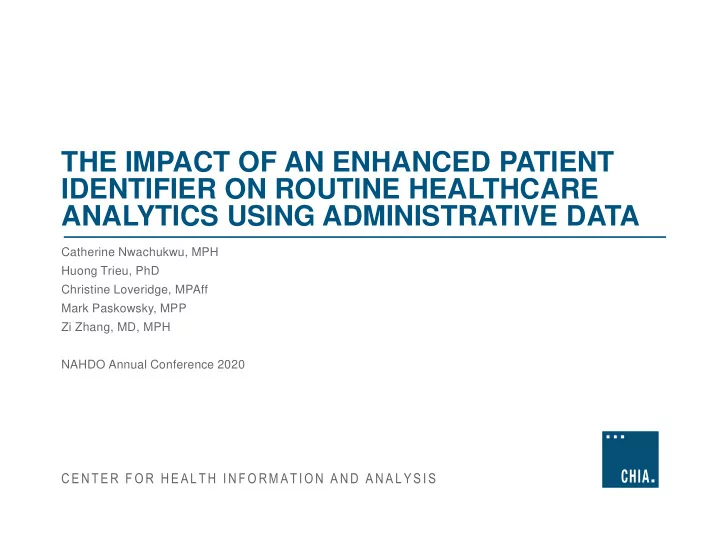

THE IMPACT OF AN ENHANCED PATIENT IDENTIFIER ON ROUTINE HEALTHCARE ANALYTICS USING ADMINISTRATIVE DATA Catherine Nwachukwu, MPH Huong Trieu, PhD Christine Loveridge, MPAff Mark Paskowsky, MPP Zi Zhang, MD, MPH NAHDO Annual Conference 2020 CENTER FOR HEALTH INFORMATION AND ANALYSIS
Agenda Background Objective Study Design Principal Findings Significance Questions & Answers 2 The Impact of an Enhanced Patient Identifier on Routine Healthcare Analytics Using Administrative Data | 2020
Background • Over the years, the completeness and validity of patient identifiers, such as Social Security Number (SSN), in administrative datasets has been deteriorating • In Massachusetts’ hospital inpatient data, 9.5% of adult discharge records had a missing or invalid SSN in 2018, a significant increase from 4.5% in 2011 • The proportion of missing or invalid SSN varies greatly by hospital, with up to 68% of records missing SSN at certain hospital, and by patient characteristics, such as payer type and age 3 The Impact of an Enhanced Patient Identifier on Routine Healthcare Analytics Using Administrative Data | 2020
Objective To examine the use of an enhanced patient identifier (EPI), instead of SSN, to link patient records, and its impact on populations studied in a statewide readmissions analysis. 4 The Impact of an Enhanced Patient Identifier on Routine Healthcare Analytics Using Administrative Data | 2020
Study Design Solution : The EPI was created using IBM Initiate Master Data Service, which utilized probabilistic matching on all available and valid patient characteristic information to identify discharge records belonging to the same patient Patient Matching Fields First and last name Zip code Date of Birth (DOB) Address SSN Health plan ID Sex 5 The Impact of an Enhanced Patient Identifier on Routine Healthcare Analytics Using Administrative Data | 2020
Study Design Matching Rules: Match Description 1. Same organization ID (i.e., data submitting entity) and medical record number 2. All fields agree 3. SSN, DOB, and Health plan ID agree, all else missing All fields agree except... 4. One field disagrees or is missing 5. Any two fields (excluding SSN and DOB) disagree 6. SSN and DOB missing 6 The Impact of an Enhanced Patient Identifier on Routine Healthcare Analytics Using Administrative Data | 2020
Study Design Data Sources: The Massachusetts’ Acute Hospital Case Mix databases were used for matching • Hospital Inpatient Discharge Database (HIDD) • Emergency Department Database (EDD) • Outpatient Observation Database (OOD) Matching data spanned from 2006 – 2018, improving the reliability and validity of patient matching. 7 The Impact of an Enhanced Patient Identifier on Routine Healthcare Analytics Using Administrative Data | 2020
Study Design Analysis: The EPI was used to identify and link patient records in a readmissions analysis and results were compared to the same analysis using SSN. Analyses included adult (18+) patients discharged from acute care hospitals in Massachusetts from state fiscal year (SFY) 2011 – 2018 (July 1, 2010 – June 30, 2018). The readmission methodology was adapted from the Yale/CMS unplanned, hospital-wide readmission measure (NQF #1789). 8 The Impact of an Enhanced Patient Identifier on Routine Healthcare Analytics Using Administrative Data | 2020
Principal Findings Trend in Statewide All-Payer Discharges and Readmissions using EPI vs. SSN SFY 2011 - 2018 9 The Impact of an Enhanced Patient Identifier on Routine Healthcare Analytics Using Administrative Data | 2020
Principal Findings Hospital-Level Percent Change in Discharges using EPI vs. SSN SFY 2018 Median: 4% 10 The Impact of an Enhanced Patient Identifier on Routine Healthcare Analytics Using Administrative Data | 2020
Principal Findings Hospital-Level Percent Change in Readmissions using EPI vs. SSN SFY 2018 Median: 3% 11 The Impact of an Enhanced Patient Identifier on Routine Healthcare Analytics Using Administrative Data | 2020
Principal Findings Trend in Discharges and Readmissions by Payer Type using EPI vs. SSN SFY 2011- 2018 12 The Impact of an Enhanced Patient Identifier on Routine Healthcare Analytics Using Administrative Data | 2020
Principal Findings Trend in Discharges and Readmissions by Age using EPI vs. SSN SFY 2011- 2018 13 The Impact of an Enhanced Patient Identifier on Routine Healthcare Analytics Using Administrative Data | 2020
Principal Findings Trend in Statewide All-Payer Readmission Rates using EPI vs. SSN SFY 2011 - 2018 14 The Impact of an Enhanced Patient Identifier on Routine Healthcare Analytics Using Administrative Data | 2020
Significance • The EPI enabled us to keep otherwise valid and complete discharge records in our analysis of readmissions, especially for certain hospitals and patient populations. • It also greatly strengthened our capacity to capture and analyze hospital discharge records from all types of hospitals and patient populations. • As the health care system continues to move towards more coordinated and integrated care for patients, the methods by which unique patients are identified is of critical importance. • Future studies should continue to explore how different linkage methodologies may impact the populations captured in key health care analyses. 15 The Impact of an Enhanced Patient Identifier on Routine Healthcare Analytics Using Administrative Data | 2020
Questions? 16 The Impact of an Enhanced Patient Identifier on Routine Healthcare Analytics Using Administrative Data | 2020
Contact Information For additional questions, please contact: Catherine Nwachukwu, MPH Associate Manager of Research Center for Health Information and Analysis (617) 701-8226 Catherine.Nwachukwu@state.ma.us 17 The Impact of an Enhanced Patient Identifier on Routine Healthcare Analytics Using Administrative Data | 2020
Recommend
More recommend